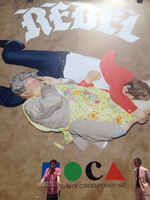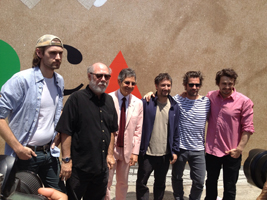A Rebel With Many Causes


James Franco, the award winning actor, writer, producer, Oscar host and PHD student decided that ‘Art Curator’ was another necessary string to his proverbial bow.
The actor explained at the recent launch of his “Rebel” exhibition that he and a friend were batting around ideas around the concept of turning traditional film into experimental art. This theme of thinking developed into repurposing the classic film Rebel Without A Cause, inspired by the work of one of Franco’s favorite artists, and the mythologies surrounding the original production, and so he set about assembling the dream team of contemporary artists, which finally included Paul and Damon McCarthy, Aaron Young, Harmony Korine, Ed Ruscha, Terry Richardson and Douglas Gordon. An interesting hunt then began to cast the role of Natalie Wood, during which many actresses were auditioned, and workshopped, knowing little about the project.
What this culminated in, opened to a small and select crowd in Hollywood on Highland Avenue in early May, in conjunction with MOCA, the Museum of Contemporary Art. Franco took to the podium to explain to the group of journalists, and a smattering of student fans, exactly where his ideas came from and developed through, and arrived at the final product – a warehouse-slash-studio space housing a mixture of traditional picture art-slash-installation art-slash-experimental film-slash-animation-slash-set design, encompassed in a recreation of the famous Chateau Marmont bungalows and pool, a location with specific reference and iconography for the James Dean classic as a venue they used audition the actor for that legendary role.

The huge drape adorning the south-facing wall of the space gives light suggestions of what to expect. The artists photographed from above, intertwined in a pseudo-69 position, one male dressed in a ladies apron, whilst the other in more Dean-esque attire buries his head in his crotch, gives hint that inhibitions were left at the door when curating this exhibition. Guests wander past the opening installation, a car stood on its nose, dipped in cement, and follow through into the main arena, where experimental projections loop in each bungalow, the bungalow structures themselves a nod to the film-making process by being finished on one side, but exposed set-build structuring on the other. The films themselves include acontinuous hand-held reportage of artist Paul McCarthy frolicking with ‘Natalie Wood’ in a bath tub, and a gang-style showdown between Franco and an adversery in a desolate parking lot, fighting to the death, each flanked by a small army of naked women wearing sneakers, in homage to the classic Rebel knife fight outside Griffith Observatory. Illustrating the edges of the pool, which also provided home to a sunken motorcycle were the most traditional pieces of the set, classic images and posters, partially burnt over a mirror and framed, which would attractively suit any film-savvy apartment of the Hollywood elite.
With this exhibition, Franco has allowed the original movie to be repurposed, regenerated, repositioned and reimagined, one can only assume is equally a metaphor for his illustrious career thus far. The subject matter and its presentation method may have delved a little too much into the obscure, gratuitous and even pornographic for the popular and commercial eye, but it has attracted the eyes of the art world, and in doing so, with the added prestige of MOCA has no doubt added yet another successful and prolific string to Mr Franco’s ubiquitous hyphenating bow.

